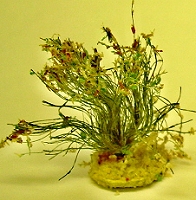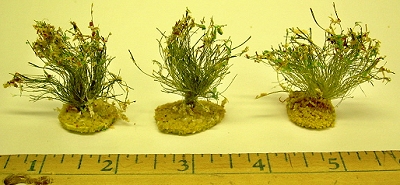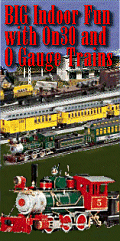|
|
Note from Editor: Glitterhouse designer/builder Howard Lamey created these "sea grass" clumps to go along with a lighthouse project we are working on. This is how he explained this fun and simple project to me.
 Modeling Sea Grass Modeling Sea Grass
I know that this technique is not new, but it works, and Paul tells me it is worth explaining to our readers.
Along most beaches on the Atlantic coast, you'll see one species or another of "sea grass." It's no fun to walk on barefoot, but it is about the only thing that will grow in that environment, and its roots help protect the beach from being washed out to sea during rough weather. It also creates a habitat for a number of bird species you seldom see anywhere else.
Near your display village structures or on your indoor railroad, it adds inexpensive charm and texture to any seaside scene.
Materials
- Several inches of hemp rope
- Cardboard for the base
- Fine wire, like florist's wire, for binding the rope bits at one end.
- White glue like Elmer's
- Acrylic paint in a neutral color like beige or light brown
- Green spray paint (optional), acrylic green paint can be diluted and used instead, or you can choose to leave the rope its natural color.
- Sand for gluing to the base. I used aquarium sand; you can use "play" sand, swimming pool filter sand, whatever looks right with the rest of your setting.
- Sawdust
Making the Grass Clumps
- Cut the hemp rope into several 2-3" lengths.
- Bind one end of each piece of rope with the fine wire (like the end of a tiny broom) and squirt some glue in for extra holding.
- Untwist the strands of the rope, then "smush" it, crimp it, and trim it to a random shape
- Mist the "clump" with green spray paint. If you have green acrylic paint instead, dilute some into a quarter-cup of water and use it to "stain" the clumps. Or you could use another color or leave them a natural color if you wish.
- Make the bases out of irregular cardboard shapes. Thick cardboard like the back of a writing tablet is best. If you use corrugated cardboard, you'll have to make a point of gluing sand around the edges to cover up the holes.
- Paint the bases; then punch a hole in the middle of each piece to fit your "clumps."
- Glue the grass clumps into the bases.
 When the assemblies have dried, glue sand over the bases. When the assemblies have dried, glue sand over the bases.
- When the sand is dry, put dots of glue randomly on the tips of the rope strands, then dip the tops of the clumps into sawdust.
- When the sawdust is dry, if you wish, you may dab different colors of paint on the bits of sawdust to represent flowers.

Conclusion
Please let us know if you find this project useful - we especially appreciate photographs.
Also, if you have a similar project you'd like to share with your fellow readers and hobbyists, we'd love to add it to our site, and we'll be sure to give you full credit for your contribution.
Return to Howard's How-To's
|



|









